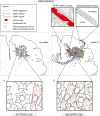Importance of GFAP isoform-specific analyses in astrocytoma
- PMID: 30667110
- PMCID: PMC6617972
- DOI: 10.1002/glia.23594
Importance of GFAP isoform-specific analyses in astrocytoma
Abstract
Gliomas are a heterogenous group of malignant primary brain tumors that arise from glia cells or their progenitors and rely on accurate diagnosis for prognosis and treatment strategies. Although recent developments in the molecular biology of glioma have improved diagnosis, classical histological methods and biomarkers are still being used. The glial fibrillary acidic protein (GFAP) is a classical marker of astrocytoma, both in clinical and experimental settings. GFAP is used to determine glial differentiation, which is associated with a less malignant tumor. However, since GFAP is not only expressed by mature astrocytes but also by radial glia during development and neural stem cells in the adult brain, we hypothesized that GFAP expression in astrocytoma might not be a direct indication of glial differentiation and a less malignant phenotype. Therefore, we here review all existing literature from 1972 up to 2018 on GFAP expression in astrocytoma patient material to revisit GFAP as a marker of lower grade, more differentiated astrocytoma. We conclude that GFAP is heterogeneously expressed in astrocytoma, which most likely masks a consistent correlation of GFAP expression to astrocytoma malignancy grade. The GFAP positive cell population contains cells with differences in morphology, function, and differentiation state showing that GFAP is not merely a marker of less malignant and more differentiated astrocytoma. We suggest that discriminating between the GFAP isoforms GFAPδ and GFAPα will improve the accuracy of assessing the differentiation state of astrocytoma in clinical and experimental settings and will benefit glioma classification.
Keywords: GFAP; GFAP variants; GFAPδ; astrocytoma; biomarker; glioma; intermediate filaments.
© 2019 The Authors. Glia published by Wiley Periodicals, Inc.
Conflict of interest statement
The authors declare no conflicts of interest.
Figures

References
-
- Bazarian, J. J. , Biberthaler, P. , Welch, R. D. , Lewis, L. M. , Barzo, P. , Bogner‐Flatz, V. , … Jagoda, A. S. (2018). Serum GFAP and UCH‐L1 for prediction of absence of intracranial injuries on head CT (ALERT‐TBI): A multicentre observational study. The Lancet Neurology, 17, 782–789. 10.1016/S1474-4422(18)30231-X - DOI - PubMed
-
- Bien‐Moller, S. , Balz, E. , Herzog, S. , Plantera, L. , Vogelgesang, S. , Weitmann, K. , … Schroeder, H. W. S. (2018). Association of glioblastoma multiforme stem cell characteristics, differentiation, and microglia marker genes with patient survival. Stem Cells International, 2018, 9628289–9628219. 10.1155/2018/9628289 - DOI - PMC - PubMed
Publication types
MeSH terms
Substances
LinkOut - more resources
Full Text Sources
Miscellaneous

